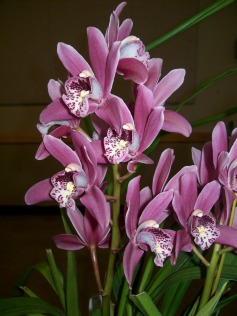Cymbidium Orchids – Species and Hybrids
Cymbidium Orchid Care
There are two main types of cymbidiums - standards and miniatures.
Standard cymbidium orchids are more cold-tolerant that other common orchid species. Miniatures are more heat tolerant and flower nicely in warm weather climates.

Flowers
Blooming season is during the winter, the best time for displaying plant indoors. Flowers grow in beautiful sprays. Spikes shoot up from pseudobulbs every season.
Cymbidium Orchid Care Tips
Lighting RequirementsCymbidium orchids thrive in semi-shade (50%) during the growing season. If they are moved outdoors during the summer (after the threat of frost), avoid direct sunlight – minimal sunlight in the morning, and shade in the afternoon.
Apple green (golden green) leaves are a signal that your cymbidium orchid plant is receiving the correct amount of light.
Temperature
They are more cold-tolerant than other popular orchids. Mature cymbidiums need a long period of cold temperature bloom. Miniatures can withstand warmer temperatures and still produce blooms.
Outdoor temperature during the summer should be 75° to 85 F° (or more). During late summer to autumn, night temperatures must be 50° to 60° F to initiate flower spikes.
During winter, temperatures should be 45° to 55° F at night and 65° to 75° F during the day. When orchids are in bloom, temperatures should be constant - between 55° and 75 F°. Bring cymbidiums indoors to a bright, cool location when temperatures dip below 40° F.
Note: Miniature cymbidium orchids can stand temperatures five to ten degrees higher than standard species and still flower.
Fertilizer
During the growing season (usually spring through late summer), use a high nitrogen fertilizer (30-10-10).
In late summer, switch to a high-phosphorus, fertilizer (10- 30-20), to encourage bloom spikes. During this time fertilize at full strength every week to two weeks.
During the winter months, fertilize once a month.
Water
During the growth season, keep soil evenly moist – water thoroughly to reduce salt build-up. Reduce the amount of watering when pseudobulbs reach full growth (usually late summer).
Reduce watering during the winter – although do not allow the soil to completely dry. Soil should be slightly damp to the touch.
Humidity
In most climates, outdoor humidity during the summer is sufficient. If you live in dry climate, you may need to grow your orchids in a greenhouse. During the winter, 40% to 50% humidity is ideal - especially if plants are in bud.
Soil
In nature, cymbidium orchids grow thin roots in loamy humus. At home, a loose organic potting mixture or a commercial paphiopedilum mix can be used. Many orchid growers recommend using fir bark, perlite, peat moss, and other loose organic material in some combination.
Propagation
The best time to propagate is when your cymbidium orchid stops flowering (typically late spring). Cymbidiums require potting every two years (or when potting medium decomposes).
Repotting
- Find the oblong growths at the base of the orchid. The growths (pseudobulbs) can be propagated for new plants.
- Cover a flat work space with butcher paper or newspaper. Tilt the orchid pot sideways and gently remove the plant from the pot. Remove as much of the potting mix from the root ball as possible.
- Find a section of the orchid roots that have at least three pseudobulbs. Gently pull it away from the main plant. Separate by working your fingers through the root ball. If necessary, use a sharp knife to cut through the smaller roots of the orchid (avoid cutting major roots).
Note: Each division
should have at least three pseudobulb growths.
- The ideal pot is 6 inches in diameter and has a drainage hole in the bottom. To ensure proper drainage, place 1 in/2.5 cm of pebbles, broken pottery pieces, or other drainage material in the bottom of the orchid pot. Fill the pot 1/2 full of orchid compost - usually consists of a mixture of peat moss, bark, sand and other matter.
- Place the pseudobulbs on top of the soil (growths should be pointed towards the middle of the pot). If you are planting several pseudobulbs per pot, space them two inches apart from each other. Fill in potting mixture around the bulbs, 2/3 of the bulbs should be visible above the soil.
- Water the soil until it is completely moist. Place newly planted orchid bulbs in a shady location. Expect roots to develop in approximately 2 1/2 months.
Longetivity
Cymbidium orchids can last many years when propagated by division.
Selection
Winter and spring are the best times to purchase cymbidiums since that is when their flowers bloom. Choose plants with golden green leaves, which are free of pests (aphids, scales, and spider mites).
Display Tips
Display in a window that receives bright light. A cool section of the home is ideal. For humidity, add a humidifier to the room or place pot on a tray of gravel filled with a small amount of water.
Other Types of Orhcids
| Cattleya Orchids - Large Stunning Blooms |
| Dendrobium Orchid - Arching Displays of Beautiful Flowers |
| Oncidium Orchid - Colorful Exotic Blooms |
| Paphiopedilum Orchid - Slipper-Shaped Flowers |
| Phalaenopsis Orchid - Elegant Long-Lasting Flowers |





